
The palaces of Florence, which are called "Palazzo", occupy one of the leading places in the lists of attractions of the city.
The palazzo in Florence was previously the home of powerful families of the city and the region, including the Medici, Strozzi and Gondi dynasties. Palaces were built in the best Italian traditions, mainly of the Renaissance, and the most famous masters of their time worked on them.
There are many palaces in Florence, some of which are "main" (the best) and can be visited today. Museums, galleries, exhibitions, bars, shops and accommodation facilities (hotels, apartments)
Villas with adjoining gardens, which used to be a place of rest and residence for influential Florentine families, are also noteworthy in Florence.
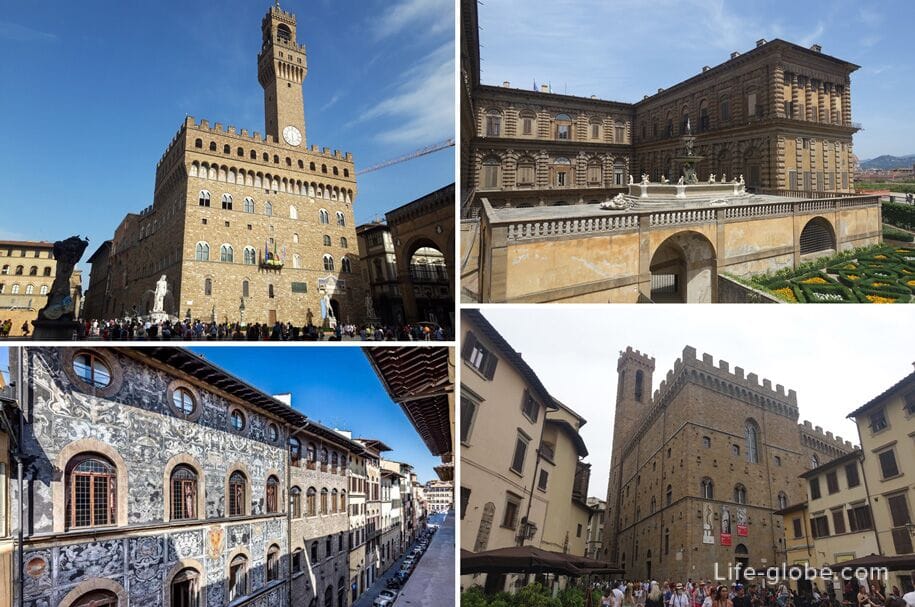
Palazzo Pitti is the largest and one of the most visited palaces in Florence.
This is a magnificent Renaissance palace, the construction of which dates back to 1458 and which was the main residence of the Medici Grand Dukes of Tuscany, then it was the Habsburg-Lorraine House during the Grand Duchy of Tuscany (since 1737), and after it was owned by the Savoy Dynasty (since 1860).
Today it is a complex museum with an adjacent building, a courtyard with a terrace, a grotto, sculptures and a fountain. There are: the Treasury of the Grand Dukes, the Palatine Gallery, the Imperial and Royal Apartments, the Gallery of Modern Art and the Museum of Fashion and Costume.
Adjacent to the palace are the Boboli Gardens (Giardino di Boboli), which together with the Pitti Palace represent an outstanding palace and park ensemble, as well as the largest museum complex in Florence, widely known in Italy and abroad.
Entrance to the Pitti Palace Museum and Boboli Gardens is paid.
Address of the Pitti Palace: Piazza de' Pitti, 1, 50125 Firenze FI, Italy.
Pitti Palace website: palazzo-pitti. More about Pitti Palace…


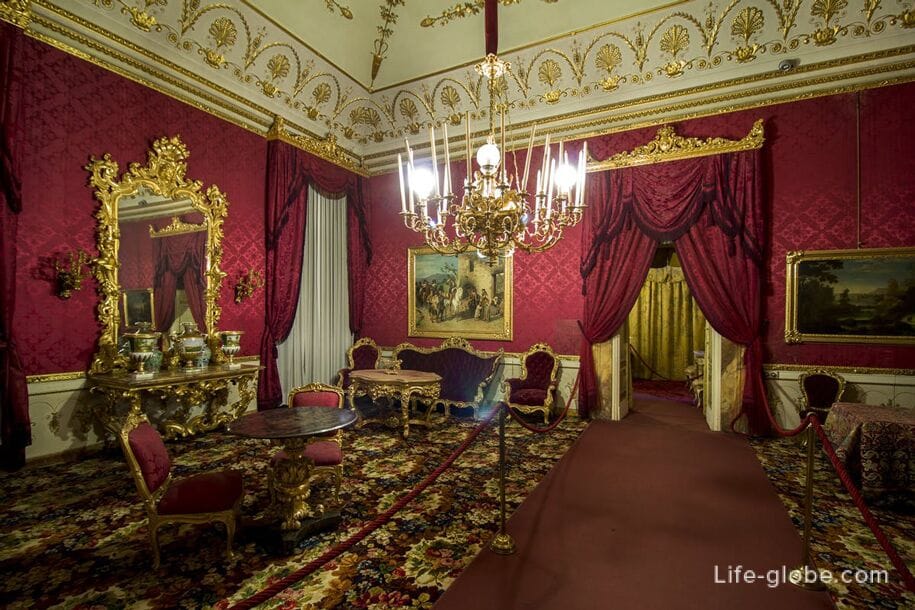
Palazzo Vecchio (Palazzo Vecchio, which translates as "Old Palace") is the city Hall of Florence, one of the most important and famous buildings in the city.
The old palace was built in 1299-1314. Then the palace was known as the Palazzo della Signoria. During the history of the palazzo was modernized and expanded.
Externally, Palazzo Vecchio looks like a small fortified castle, and the Arnolfo tower only enhances the appearance of the entire structure.
Today, the Vecchio Palace can be visited, there is a museum with courtyards and beautiful historical halls. There is an observation deck in the Arnolfo Tower.
Entrance to the palace museum and ascent to the observation deck in the towers are paid.
The Vecchio Palace is located in the heart of historic Florence, on the famous Piazza della Signoria, which also has other palaces, at: P.za della Signoria, 50122 Firenze FI, Italy.
Website of the Vecchio Palace-Museum: museo-di-palazzo-vecchio. More about Palazzo Vecchio with a museum and a tower with an observation deck…
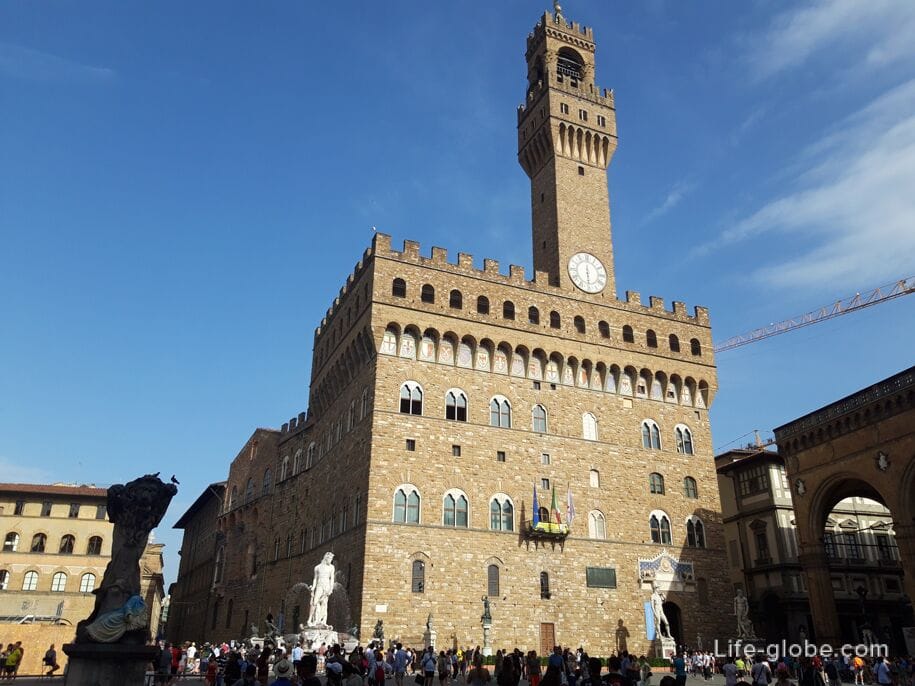
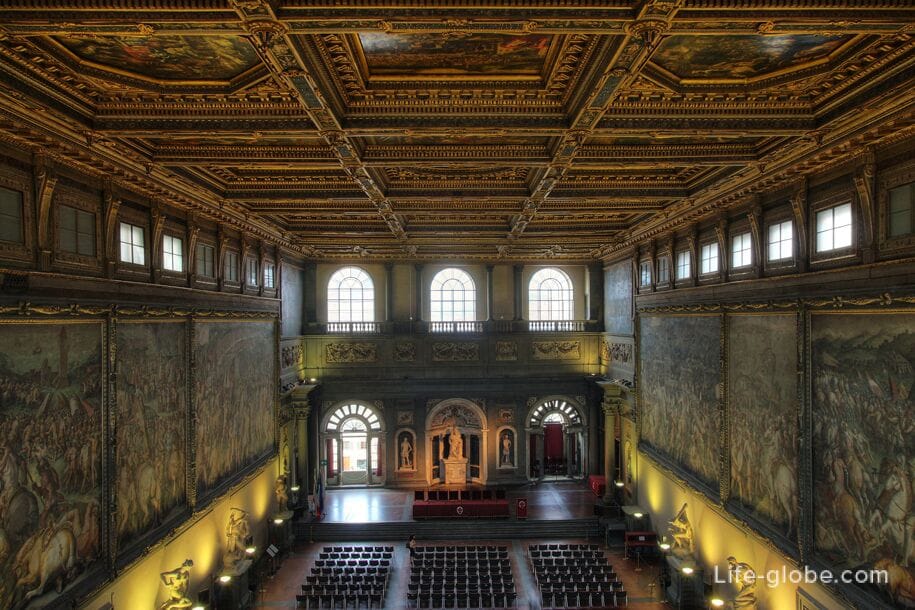
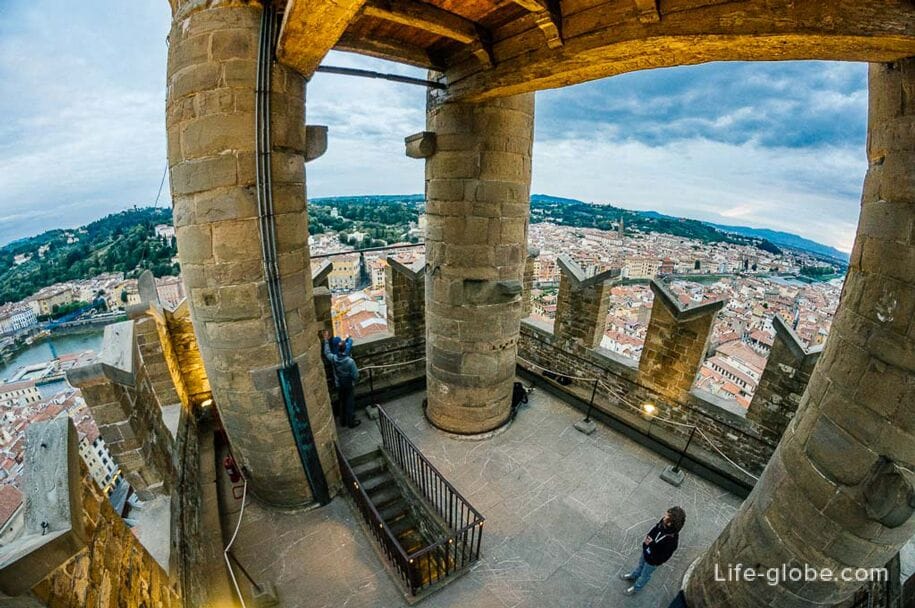
The Uffizi Gallery (Galleria degli Uffizi) is located in a historic building, which is commonly called the palace, and the construction of which was started in 1560 as a magistracy commissioned by Cosimo I de' Medici, to house the "Uffizi", that is, the administrative and judicial institutions of Florence.
This monumental but visually airy building with a beautiful courtyard is today the most famous art museum in Florence, which houses a collection of priceless works of art, especially from the Italian Renaissance period.
Entrance to the Uffizi Gallery is paid.
The address of the Uffizi Gallery: Piazzale degli Uffizi, 6, 50122 Firenze FI, Italy.
Uffizi Gallery website: gli-uffizi. More about the Uffizi Gallery…

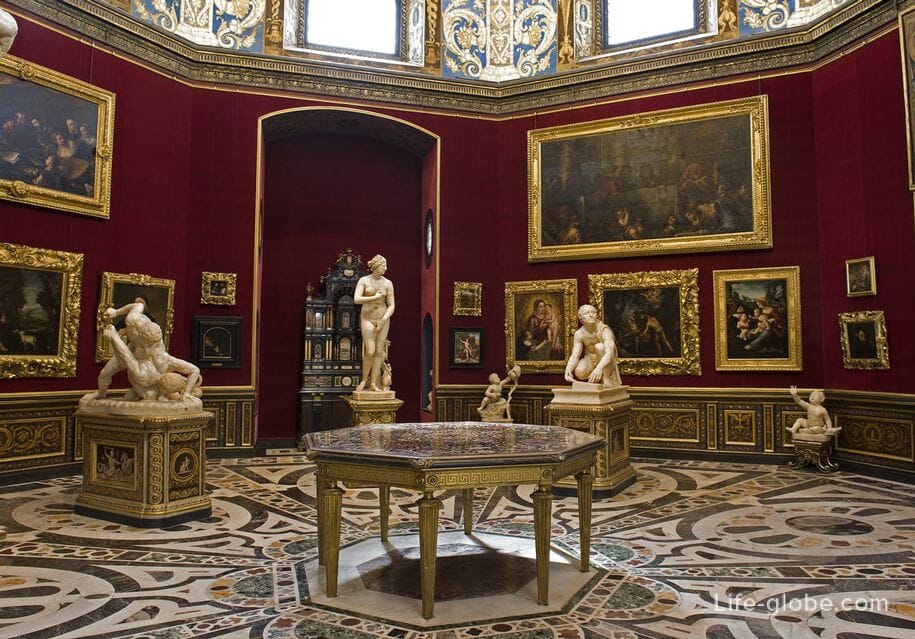
The Palazzo del Bargello, also known as Palazzo Popolo (Palace of the People, Palazzo del Popolo / Palace of the People) is the oldest public building in Florence, built starting in 1255 to house first the Captain del Popolo (an administrative title in the Middle Ages in Italy), and then, in 1261, Podesta, superior magistrate of the City Council of Florence.
The building is considered an example of the "vernacular style" and has a strict jagged appearance, arched windows and a former watchtower.
Now the palace is the Art National Museum of Bargello (Museo Nazionale del Bargello), which houses some of the most important sculptures of the Renaissance, including masterpieces by Donatello, Luca della Robbia, Verrocchio, Michelangelo and Cellini, mainly from the collection of the Medici Grand Duke.
Entrance to the palace museum is paid.
The address of the Bargello Museum: Via del Proconsolo, 4, 50122 Firenze FI, Italy.
Website of the Bargello National Museum: bargellomusei.beniculturali.it. More about the Bargello Palace Museum…

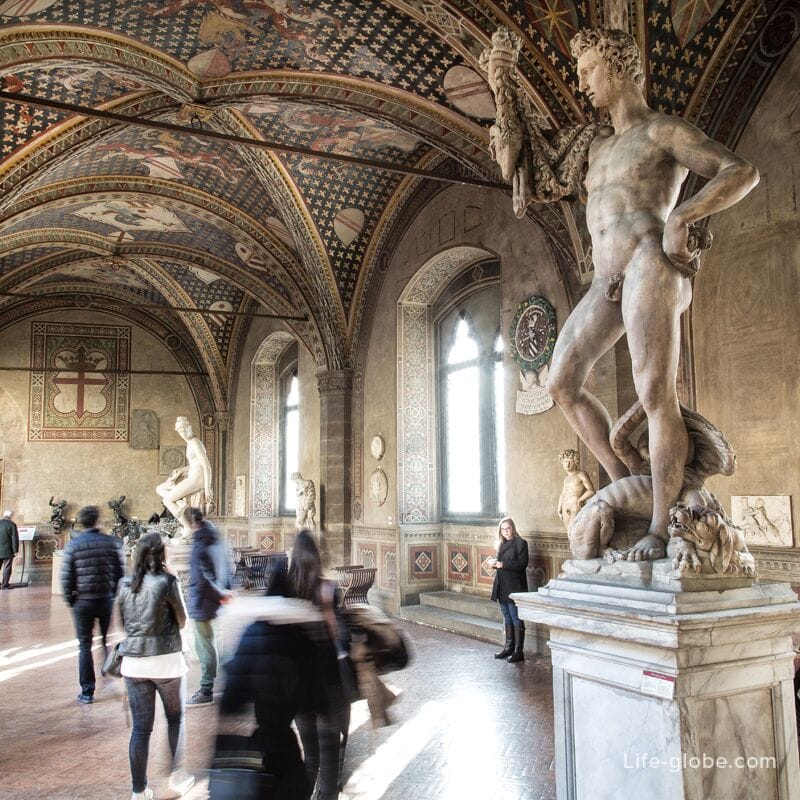
Palazzo Medici Riccardi (Palazzo Medici Riccardi) is a historical Renaissance palace, which was the first residence of the Medici family, and after that, the Riccardi family, who expanded the palace.
The palace was built between 1444 and 1484 by the architect Michelozzo di Bartolomeo. Famous masters and artists such as Michelozzo, Donatello, Michelangelo, Paolo Uccello, Benozzo Gozzoli and Botticelli worked in the palace.
Today it is a famous museum with halls with exhibitions, a chapel of the Magi, a courtyard and an adjacent garden.
Entrance to the Medici-Riccardi Palace is paid.
Address of the Medici Riccardi Palace (entrance): Via Cavour 1, 50121 Firenze.
Website of the Medici-Riccardi Palace: palazzomediciriccardi.it. More about the Medici-Riccardi Palace…
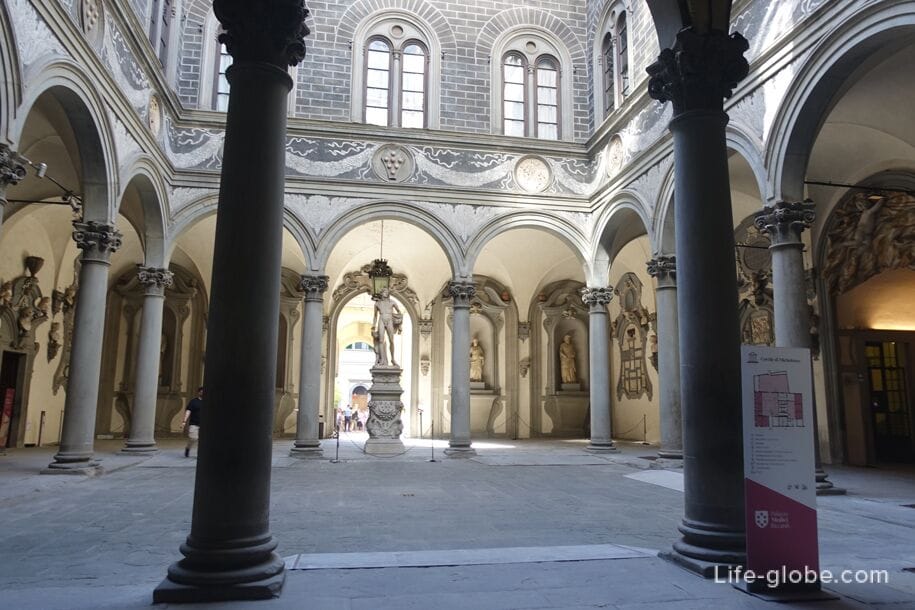

The Strozzi Palace (Palazzo Strozzi) is a Renaissance palace, named after the influential Florentine Strozzi family, who built and lived in the palace.
The palace was erected by order of Filippo Strozzi, after the expulsion of the Strozzi family men from Florence was canceled in 1466, and they returned back to the city.
Today, the former palace is a magnificent example of noble mansions of the Italian Renaissance.
The palace has a beautiful courtyard, is one of the most important museums in Florence and is used as a venue for cultural and exhibition events and fashion shows.
The cost of entrance tickets to the palace depends on the exhibition or event held in the palace. You can enter and see the courtyard of the palace for free.
Strozzi Palace address: Piazza degli Strozzi, 50123 Firenze FI, Italy.
Strozzi Palace website: palazzostrozzi.org. More about Strozzi Palace…


The Palazzo Gondi in the Italian Renaissance style is one of the best in Florence.
The palace was built by order of Giuliano di Lionardo Gondi in 1490-1501.
Today, the palace, with its monumental courtyard and interiors with frescoes, paintings by Italian and French artists, as well as furniture, sculptures and other decorations and household items, still belongs to the descendants of the Gondi family, and it can be visited partially by appointment. There is a bar on the ground floor.
Events and private evenings are held in the halls of the palace. On infrequent open days, free access to the palace is possible.
Address of the Gondi Palace: Via dei Gondi, 2, 50122 Firenze FI, Italy.
Website of the Gondi Palace: palazzo-gondi. More about Gondi Palace…
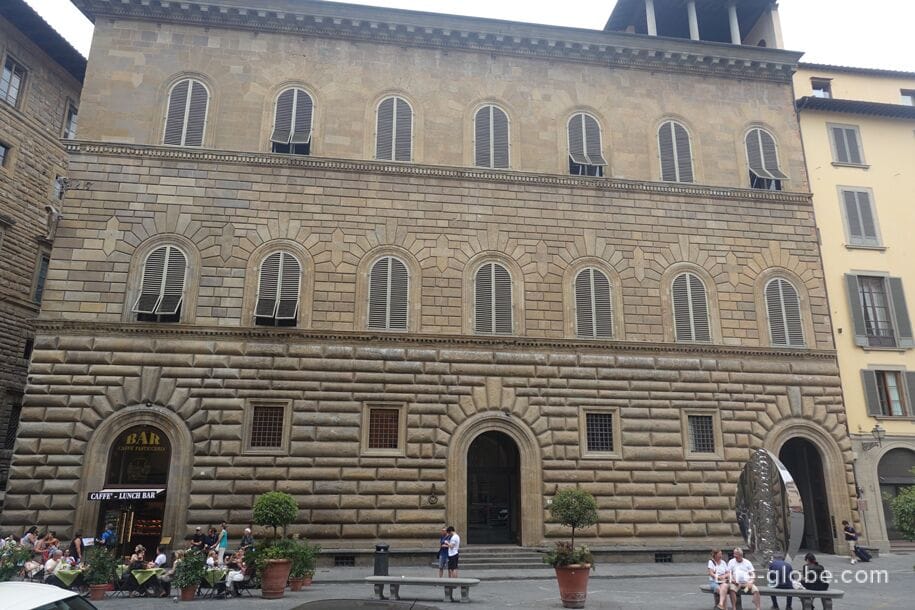
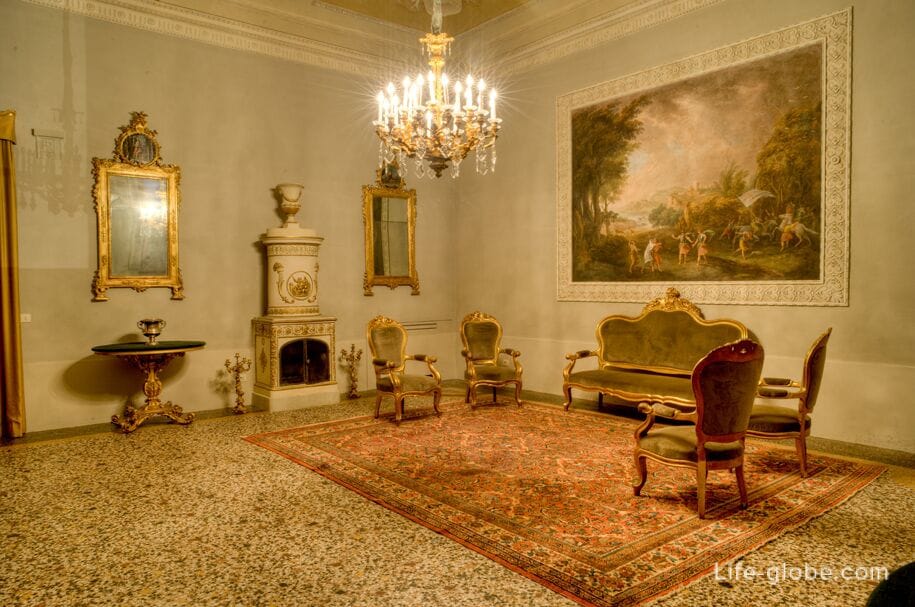
The Palazzo Davanzati displays a magnificent example of a Florentine house.
The building was built by the Davizzi merchant family around the middle of the 14th century. In 1578, the house was bought by the Davanzati family for personal use.
Today, the palace houses the museum of an ancient Florentine house (il Museo della Casa Fiorentina Antica) with a courtyard, recreated interiors and furniture, and is a magnificent and unique example of a medieval house in Florence.
Address of the Davanzati Palace Museum: Via Porta Rossa, 13, 50123 Firenze FI, Italy.
Davanzati Palace Museum website: davanzati. More about the Davantsati Palace Museum...
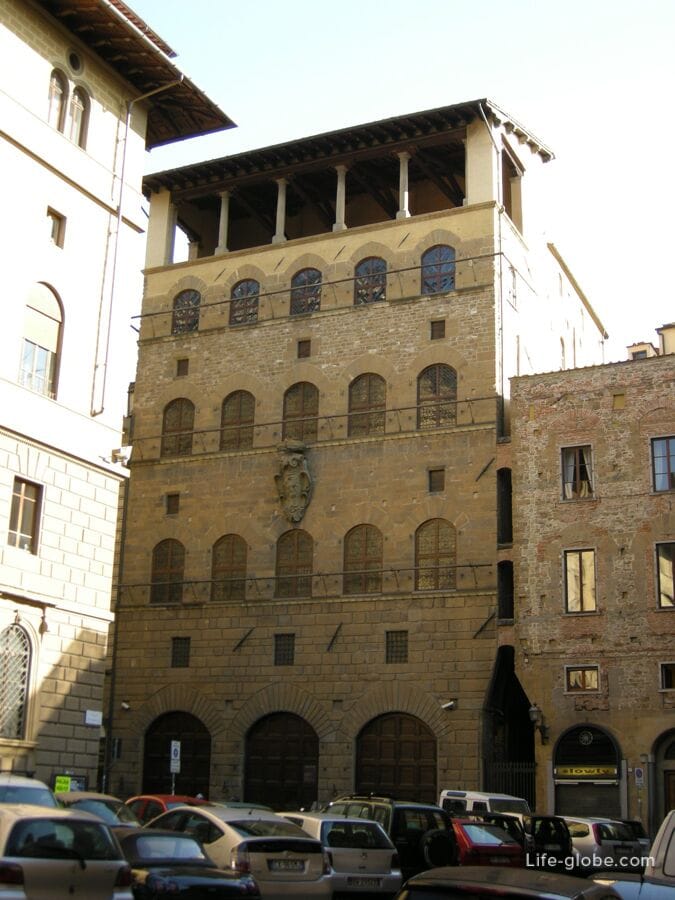
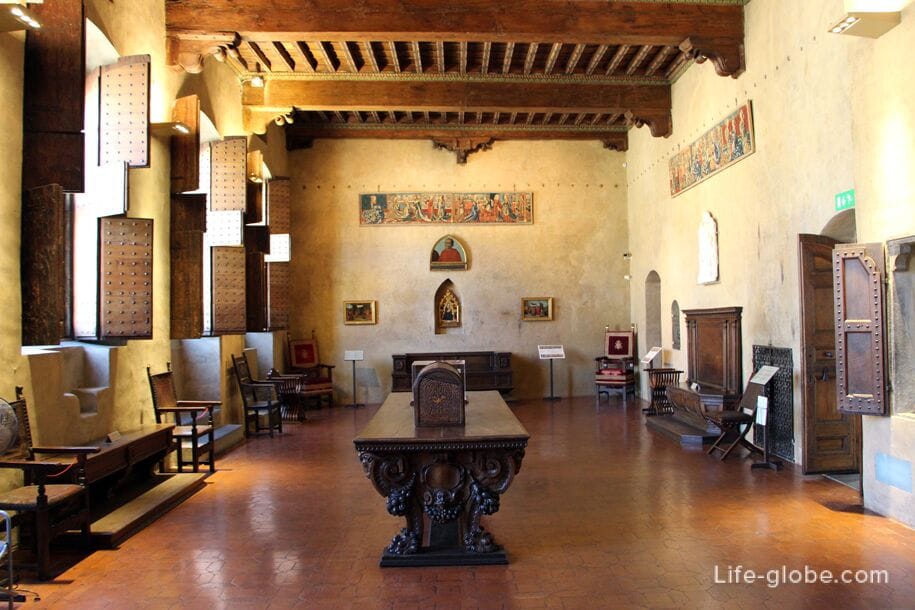
Corsini Palace (Palazzo Corsini) or Corsini al Parione Palace (Palazzo Corsini al Parione) is one of the monumental and most luxurious private palaces in Florence.
Initially, there was a small house with a garden of the Medici family on this site. In 1649, the palace, which was the property of Duke Ferdinando II de' Medici, was acquired by Maria Magdalena Macchiavelli, the wife of Marquis Filippo Corsini. Bartolomeo Corsini (son of Maddalene Machiavelli) began construction of a new palace with a chapel in 1656. The palace still belongs to the Corsini family.
The palace has a late Baroque style, consists of three main buildings, a central terrace with a balustrade and an inner courtyard. The facades are decorated with stone statues and terracotta vases.
The interior decoration of Palazzo Corsini is an example of Florentine painting from 1692-1700. The interiors of the palace have preserved halls with beautiful frescoes, stucco molding and a grotto; there is a grand staircase, a majestic Throne Room and a terrace.
The palace now hosts various events and cultural events. You can also visit the palace with a guided tour by appointment.
The main facade of the Corsini Palace overlooks the Arno River. Address of the Corsini Palace: Lungarno Corsini, 10, 50123 Firenze FI, Italy.
Website of the Corsini Palace: palazzocorsini.it. More about the Corsini Palace…

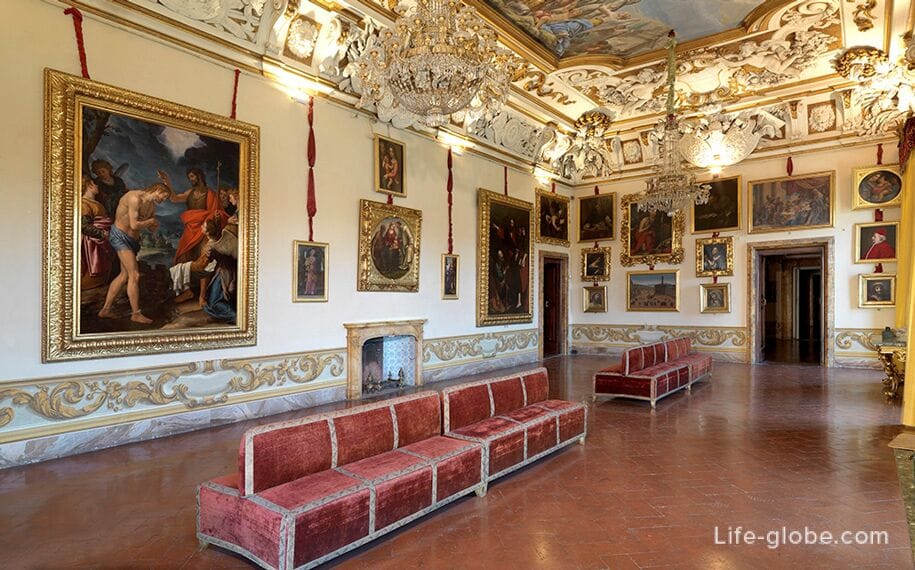
The ancient Palazzo Castellani originally dates back to the 11th century and was known at the time as part of the Castello d'Altafronte, which was fortifications of the city. The castle passed to the Uberti family in 1180, after which it was rebuilt for use as a private residence. Subsequently, the building was bought by the Castellani family.
Today it houses the Galileo Museum (Museo Galileo), which houses one of the most important collections of scientific instruments in the world, which come from the collections of the Medici dynasty and the Grand Dukes of Lorraine, as well as scientific instruments and personal belongings of Galileo Galilei.
Entrance to the Galileo Museum is paid.
Address of the Galileo Museum: Piazza dei Giudici, 1, 50122 Firenze FI, Italy.
Galileo Museum website: museogalileo.it. More about the Galileo Museum…
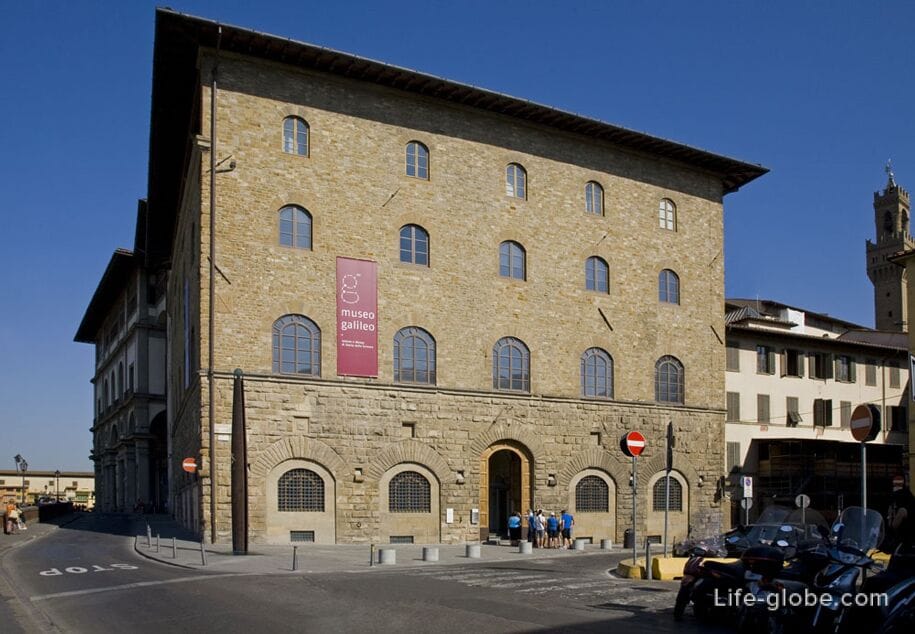
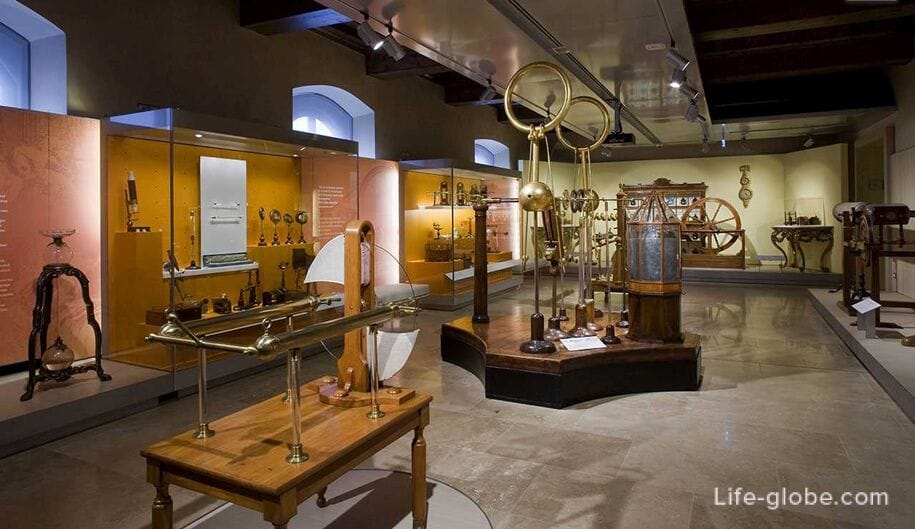
The 16th-century Palazzo di Sforza Almeni may have been designed by Bartolomeo Ammannati for Piero d'Antonio Taddei.
The palace was confiscated from the family of Taddei Cosimo I de' Medici and presented to his secretary and minister Sforza Almeni, who enriched the palace with picturesque decorations.
Today the palace looks somewhat extravagant, has some decorations on the main facade, as well as internally frescoes with allegorical images and decorative friezes with cherubs and festoons of the late 17th century.
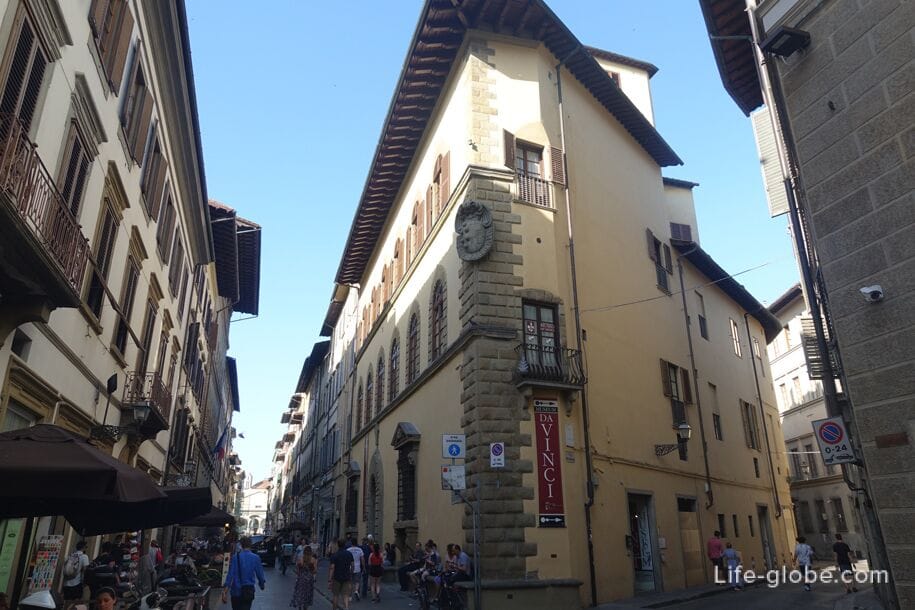
There are two museums within the walls of the palace:
- Leonardo Da Vinci Museum, which presents interactive machines: working models created by hand according to the original sketches of the Italian famous scientist and artist Leonardo. The museum's website: museoleonardodavincifirenze.com;
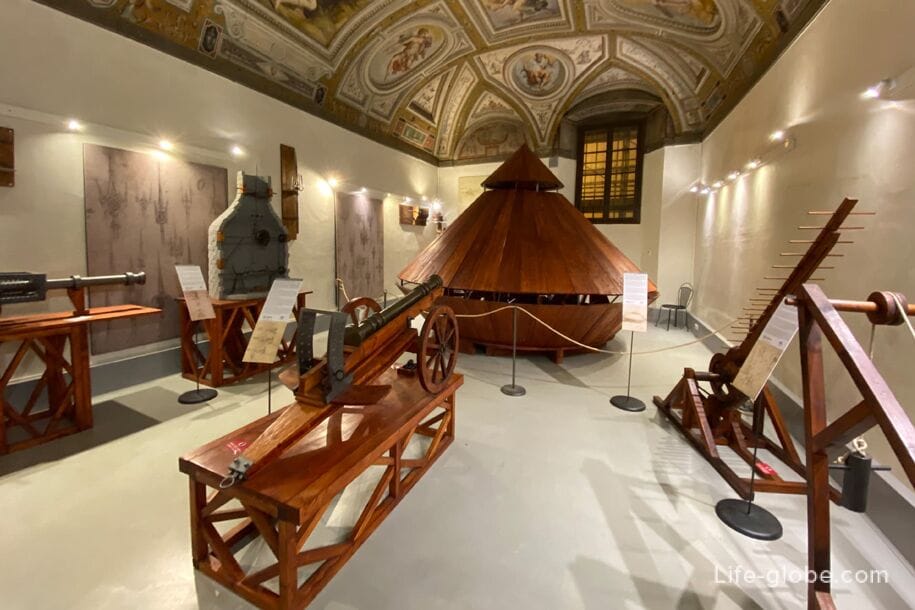
- the Museum of the History of the Medici (Museo de' Medici), which tells about the history of the great Medici dynasty, which is illustrated in the museum with a collection of original works of art: portraits of the Medici Grand Dukes, sculptures, bronze products, medals, drawings and pastels, as well as documents and relics that are direct witnesses of the centuries-old Medici rule in Florence. The museum's website: museodemedici.com.
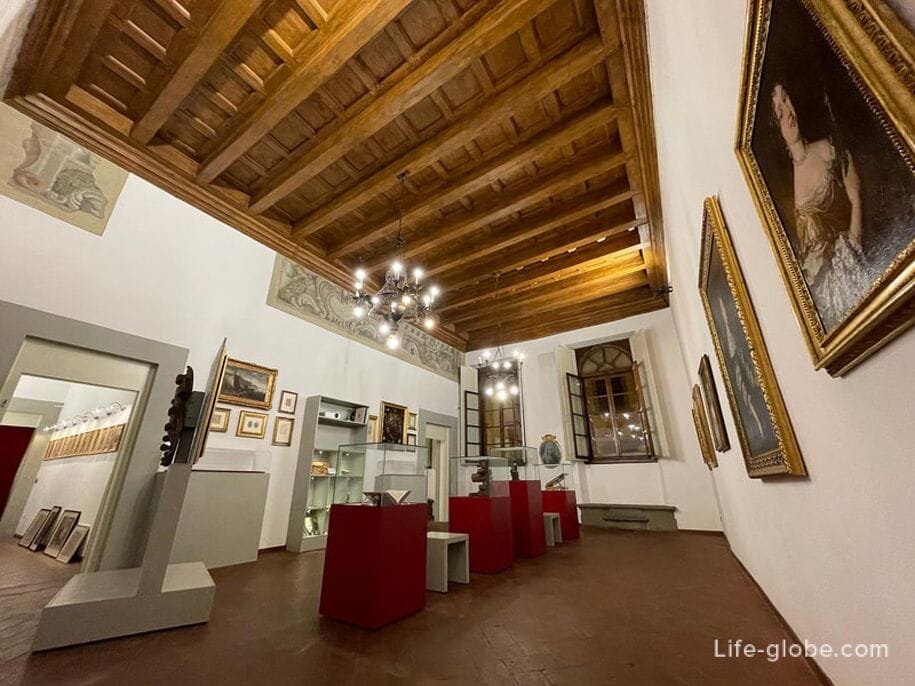
Entrances to museums are paid.
Address of the Sforza Almeni Palace: Via dei Servi, 12, 50122 Firenze FI, Italy. More about the palace and museums…
The Crocetta Palace (Palazzo della Crocetta) was built in 1619-1621 to accommodate Princess Maria Maddalena Medici, sister of the Grand Duke Cosimo II, who was in poor health (possibly with mental retardation), and so that she could safely go to mass in a nearby Basilica of Santissima Annunziata (Holy Annunciation, Santissima Annunziata), without going down to the street, because it was difficult for her to climb stairs, and also, so as not to attract the eyes of strangers.
For movement, a hinged gallery was built-a corridor connecting the palace with the church. At the end of the corridor, a small room with a lattice was built, from where a woman could watch the masses in the basilica. This corridor is called the "corridor of Maria Maddalena Medici" (Cavalcavia di Maria Maddalena de' Medici).

Today, the former Crocetta Palace with a garden houses the National Archaeological Museum of Florence (Museo Archeologico Nazionale di Firenze), which contains the best excavation materials from all over Tuscany, finds from Lazio and Umbria, with important Etruscan and Roman finds, as well as collections related to other civilizations, such as the Egyptian section and one of the Greek vaz.
Entrance to the museum is paid.
Website of the Archaeological Museum: firenze-maf-museo-archeologico-nazionale.
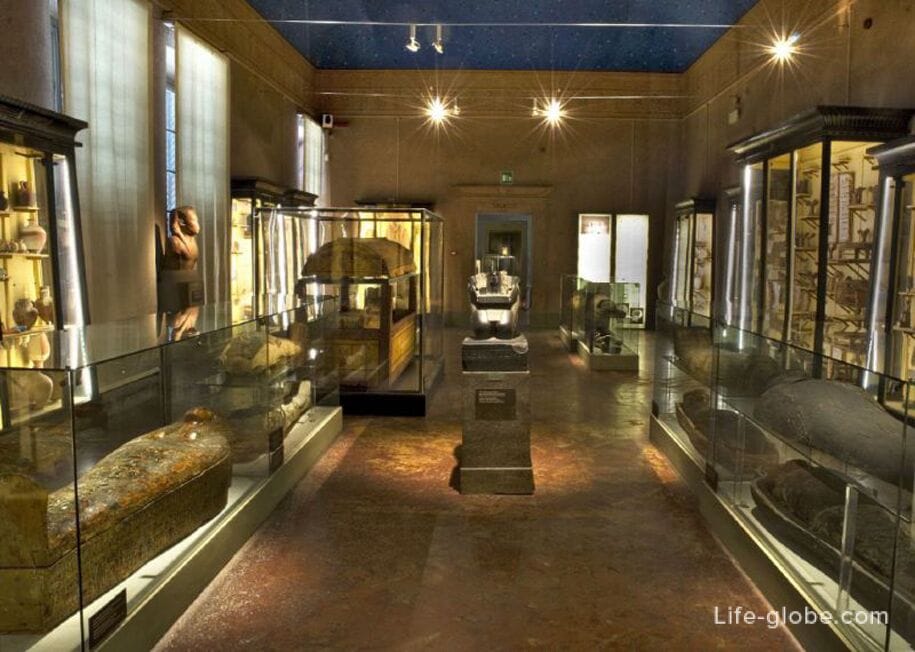
The Crocetta Palace is located on the beautiful Piazza Santissima Annunziata (the Most Holy Annunciation, Piazza della Santissima Annunziata), which also houses other palaces. One of the windows of one of the palaces on the square is never completely closed, because an interesting legend is associated with this window. Learn more about the square, palaces and legend…

Palazzo Spini Feroni is one of the palaces on Piazza Santa Trinita, which is the most monumental on the square and looks even a little harsh.
This Gothic palace was built in 1289 by the wealthy cloth merchant and banker Geri Spini. In 1874, the palace was partially renovated in the neo-medieval style. In the 1930s, it was bought by shoe designer Salvatore Ferragamo.
Today Palazzo Spini Feroni remains one of the best examples of medieval residential architecture in Florence, even though its archaic appearance is partly the result of restorations. Also, the building retains a solid look of a defensive fort, characteristic of those times when the noble families of Florence had to defend themselves primarily from their own fellow citizens.
Inside the Spini Ferroni Palace, some frescoes, stucco molding, a vestibule with a coat of arms decoration, an ancient well and a chapel with frescoes by Bernardino Pochchetti from 1609-1612 depicting Paradise with a choir of musical angels in the vault and the Worship of shepherds on the altar have been preserved.
In the palazzo there is a boutique store "Salvatore Ferragamo" and the Ferragamo Museum (Salvatore Ferragamo Museum), which is a fashion museum dedicated to the life and work of the Italian shoe designer Salvatore Ferragamo and his company of the same name. The museum's website: ferragamo.com/museo. More about Santa Trinita Square and the Palace…

Palazzo dell'antella (Palazzo dell'antella) appeared due to the unification of several houses and is now one of the most prominent elements of the Piazza Santa Croce.
The first significant expansion of the palace dates back to the mid-sixteenth century, when the building belonging to Del Barbigia was raised by one floor, and the wooden ledges were replaced by stone ones, which are still visible today. At the beginning of the seventeenth century, the building passed to Senator Niccolo Dell'Antella, who bought a neighboring house and gave them a single look, completely painting the facade with frescoes. The decoration on the theme of Virtue and Divinity was completed in a few weeks in 1619 by a team of thirteen young artists under the direction of the Italian artist Giovanni da San Giovanni.
Today this building has a beautiful complex facade decorated with frescoes depicting allegorical figures, cherubs, foliage, flowers and arabesques, which are placed around and above the bust of Cosimo II de' Medici.
Inside the palace stand out: frescoes of the seventeenth century, an atrium with wooden beams and a small courtyard with low arches (partially walled up). More about Santa Croce Square and the Palace…
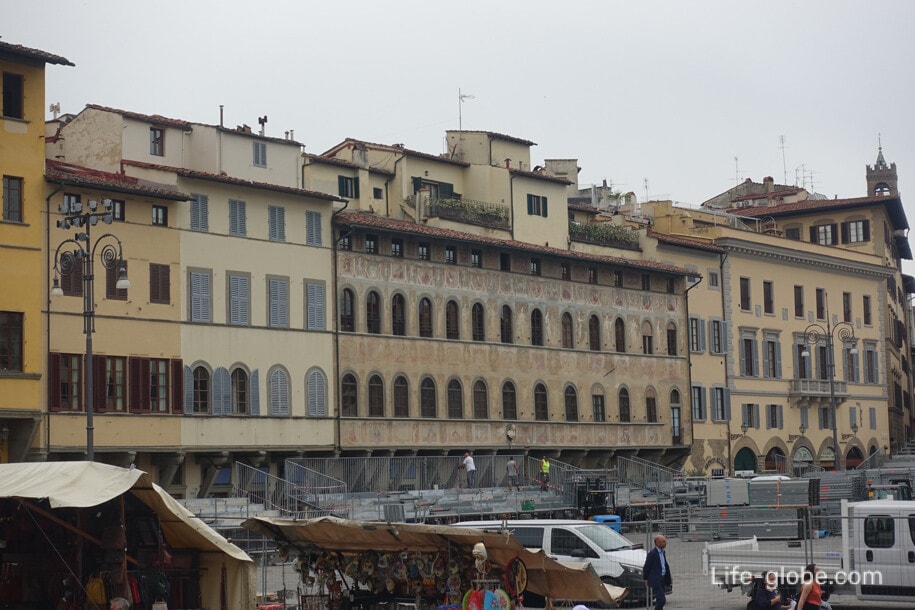
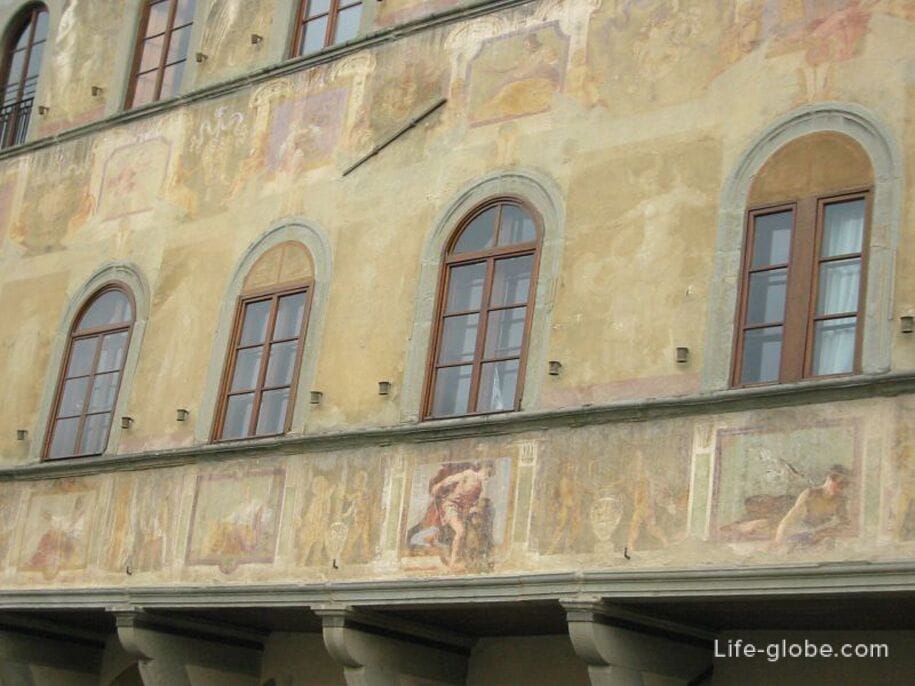
The Palazzo Rucellai of the Italian Renaissance is considered one of the best examples of Florentine civil architecture of the Quattrocento period in Florence.
The palace was built between 1446 and 1451 by order of Florentine merchant and philanthropist Giovanni Rucellai (not to be confused with the poet Giovanni Rucellai) architect Bernardo Rossellino designed by Leon Battista Alberti.
The building still belongs to the Rucellai family and it is impossible to visit it, there is also a shop in the walls of the palace. Nevertheless, today this beautiful palace with a courtyard is one of the best examples of fifteenth-century architecture in Florence.
Address of the Rucellai Palace: Via della Vigna Nuova, 18, 50123 Firenze FI, Italy.
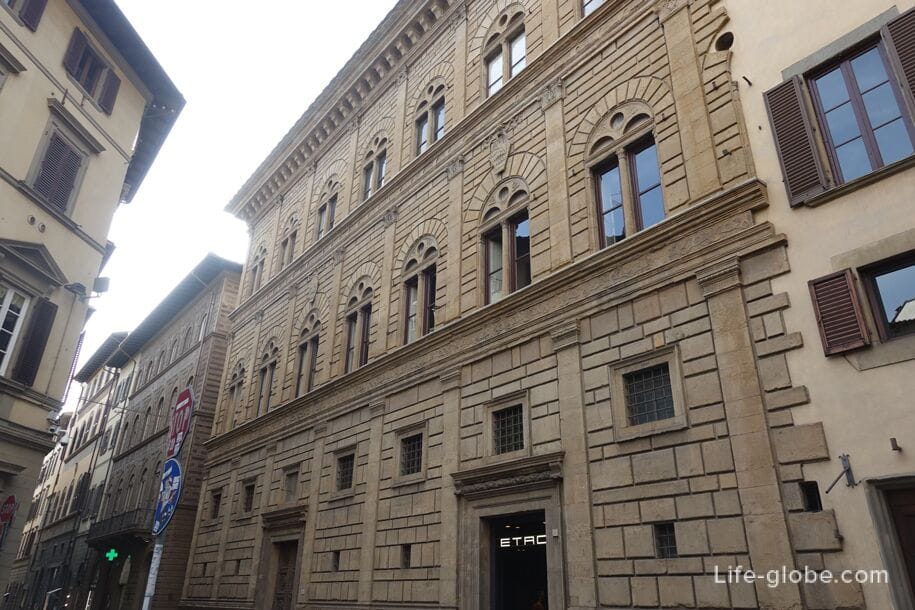
All Saints Square (Onissanti Square, Piazza Ognissanti) in The historic center of Florence is notable for several palaces, two of which are now hotels where famous people stayed.
The Palazzo Lenzi (Palazzo Lenzi), which originally dates back to 1470, and today is the residence of the French Institute; it also houses the Honorary Consulate of France and the French Library. Art exhibitions, theatrical productions, conferences and other cultural events are held periodically in the palace.
The palace has murals, a shield with the coat of arms of the Lenzi family, vaults with capitals, frescoes and an Alcove hall with stucco decorations and an arch with the coats of arms of the former owners. There is also an eighteenth-century Assumption of the Virgin in the walls of the building, possibly indicating the use of the room earlier as a private chapel.
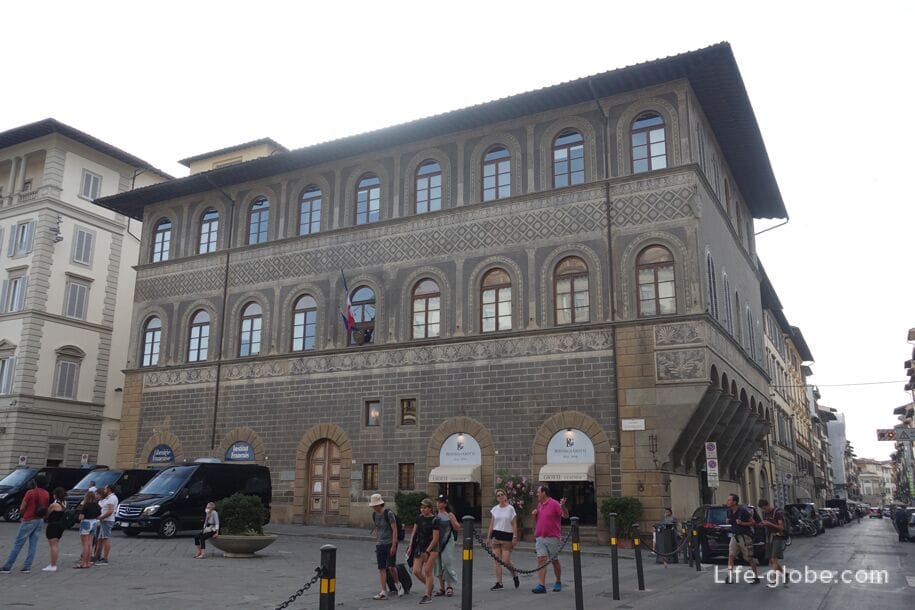
Palazzo Giuntini, which dates back to the end of the 19th century and is now a 5-star hotel The St. Regis Florence, where such famous personalities as Queen Victoria and the American singer Madonna have stayed throughout history. Link to the hotel
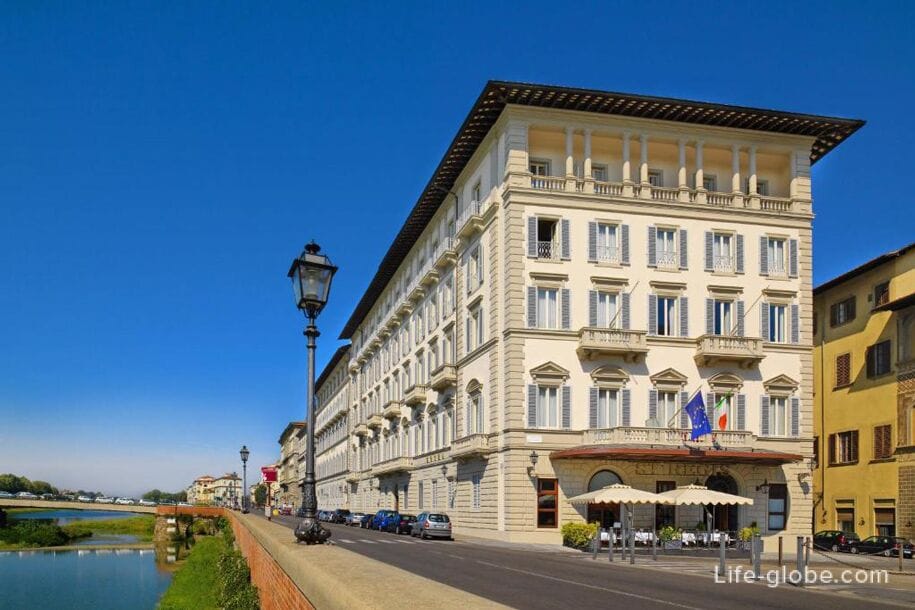

The Bonaparte Palace, which was modernized during the time until it was turned into a hotel where famous personalities stayed: from Arthur Rubinstein to Charlie Chaplin, and from Francoise Sagan to Orson Welles and Henry Ford.
Today it is a 5-star hotel The Westin Excelsior, Florence with a rooftop garden with views of Florence and the Arno River. The room rate can include: breakfast or breakfast + dinner. Link to the hotel

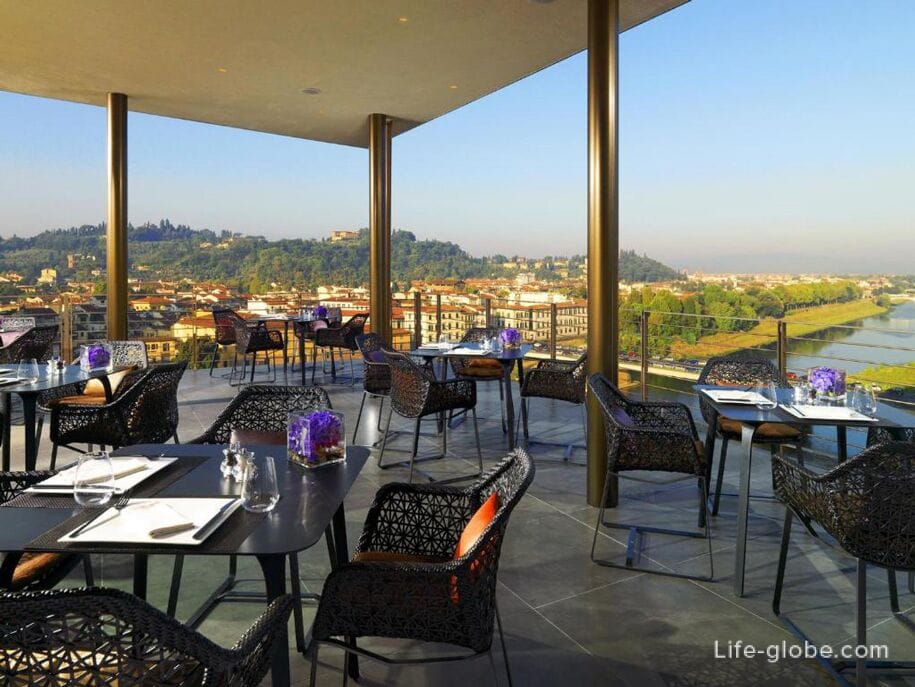
Strozzino Palace (Palazzo dello Strozzino) is a Renaissance palace with one stone Renaissance facade and built around 1457 by Filippo Brunelleschi.
The name Strozzino comes from the fact that the palace was the residence of a branch of the Strozzi family, and it was older and smaller than the nearby grand Palazzo Strozzi.
The Strozzino Palace was partially demolished during the period when Florence was the capital of Italy (1865).
The palace houses the Odeon cinema, designed in 1920 by Marcello Piacentini. It was one of the first movie theaters in Italy.
Odeon Cinema website: odeonfirenze.com.
Strozzino Palace address: Piazza degli Strozzi, 50123 Firenze FI, Italy.
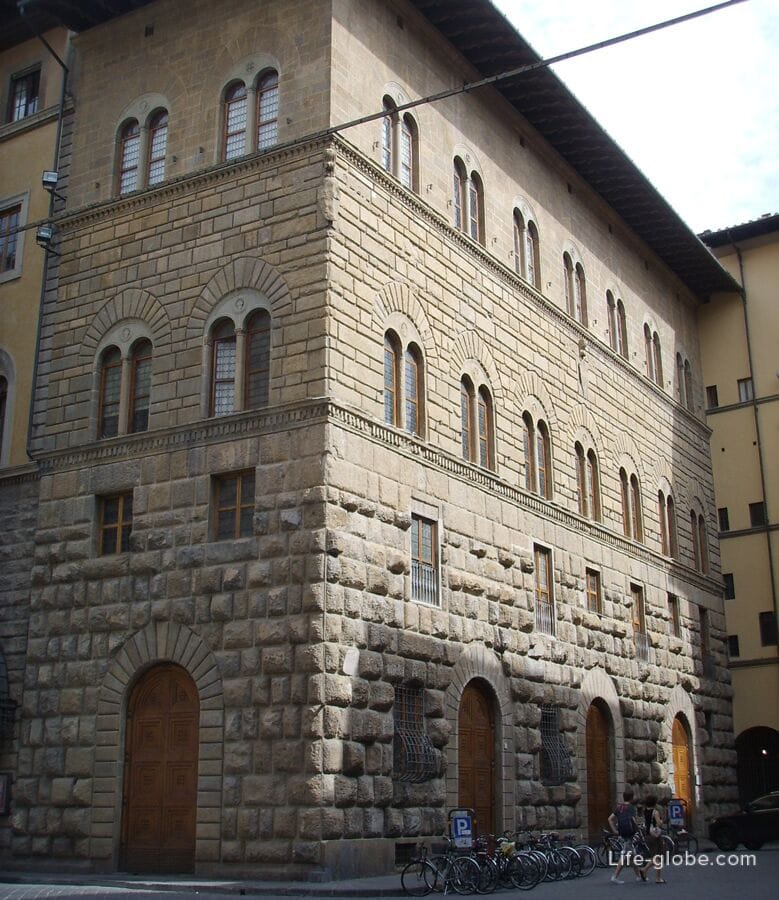

Bianca Capello Palace (Palazzo di Bianca Cappello) was built at the request of Francesco I de' Medici for his mistress Bianca Capello. Therefore, the palace is primarily known for being the scene of one of the most talked about love stories of the Renaissance between a Grand Duke and a Venetian noblewoman.
The palace was built by the Italian architect Bernardo Buontalenti in 1570-1574, in the closest possible location to the residence of the Grand Dukes - Palazzo Pitti.
After the death of Francesco I de' Medici's wife, Giovanna, the lovers married in 1579. The Bianca Cappello Palace was sold by Bianca, after she became the Grand Duchess, to the Santa Maria Nuova Hospital, after which the famous grotesques by the Italian painter Bernardino Pochchetti of 1579-1580 were painted on the facade of the palace.
The building has an underground corridor that starts from the foundation and leads to the Palazzo Pitti. Bianca Capello and Francesco I used the tunnel to meet secretly when they were lovers. Thanks to this corridor, many works that were then in the Vasari corridor in Florence were saved during the Second World War. At that time, the corridor was walled up in different sections to protect the work from the Germans, and today it is no longer accessible.
Today, the Palazzo Bianca Cappello Residenza d'Epoca is located in the palace with free Wi-Fi and private parking. Link to the hotel
The address of the palace: Via Maggio, 26, 50125 Firenze FI, Italy.
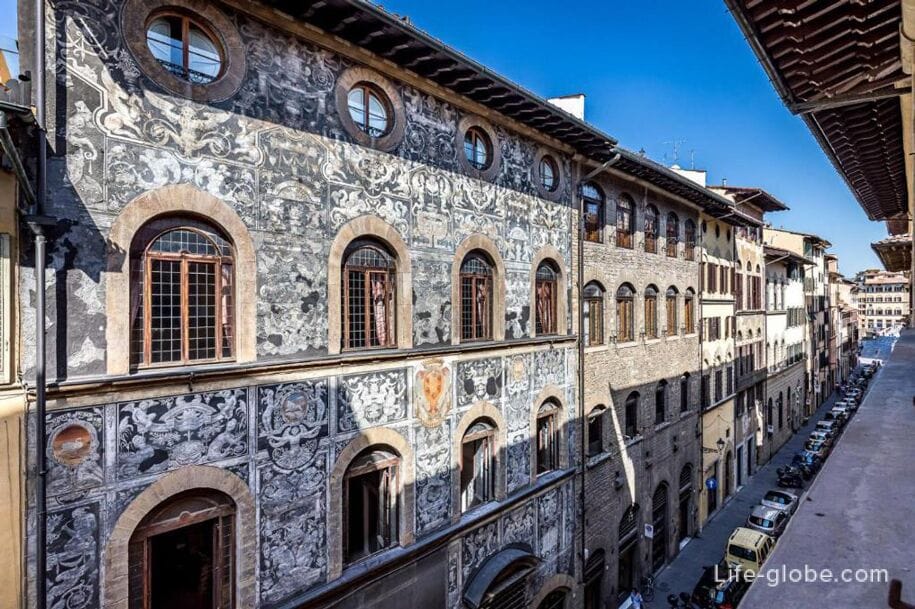

Fenzi Palace (Palazzo Fenzi), also known as Palazzo Fenzi-Marucelli, is considered the hidden gem of Florence.
The palace was built in the 16th century for the Castelli family by Gherardo Silvani, and later expanded by the Marucelli family. In 1829, it was bought by Emanuele Fenzi to house his bank and family.
It is currently home to the Faculty of History of the University of Florence.
The interiors of the palace have preserved the Baroque style with richly decorated ceilings and marble sculptures, many frescoes, some of which were made by the artist Sebastiano Ricci during his stay in Florence from 1706 to 1707 and are now considered one of his masterpieces.
You can visit the palace with prior approval from the university. Website: sagas.unifi.it.
The address of the palace: Via S. Gallo, 10, 50129 Firenze FI, Italy.
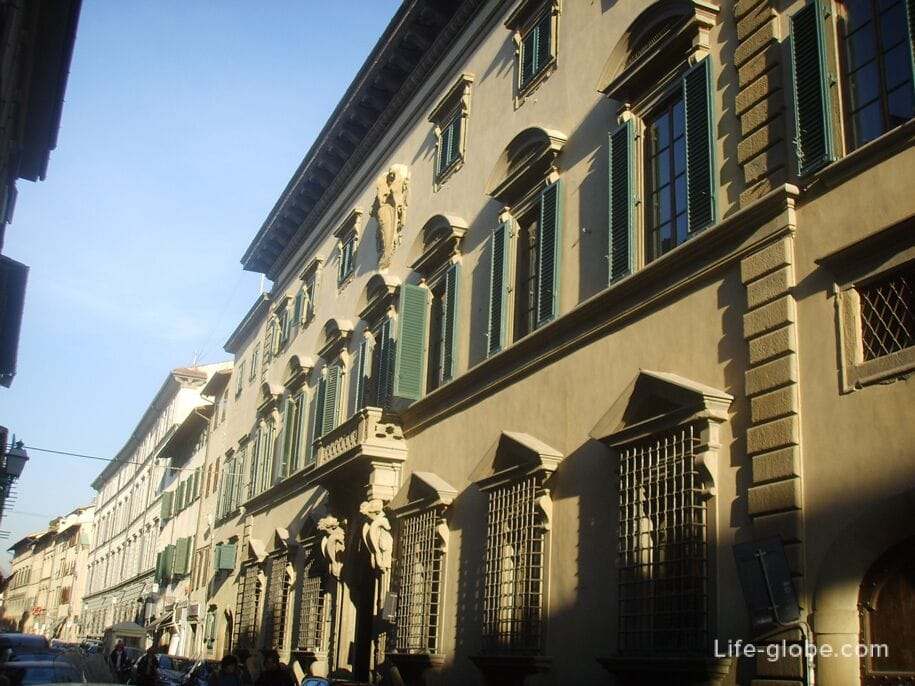
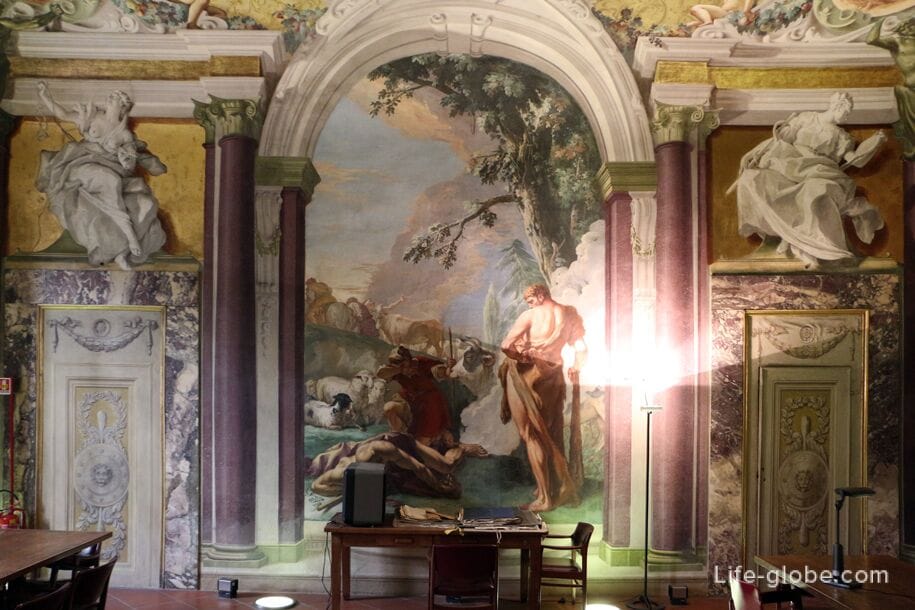
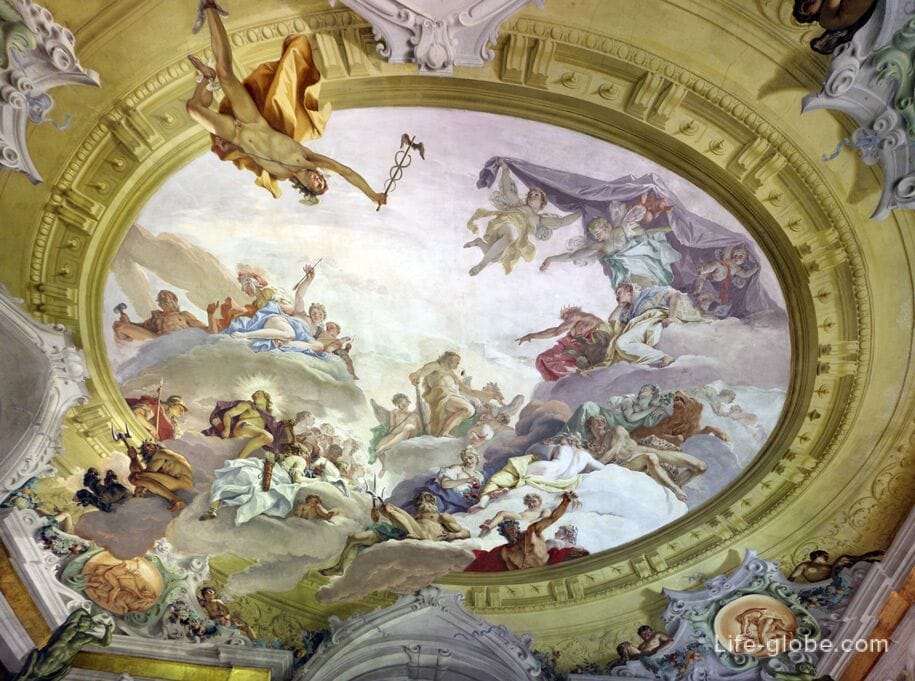
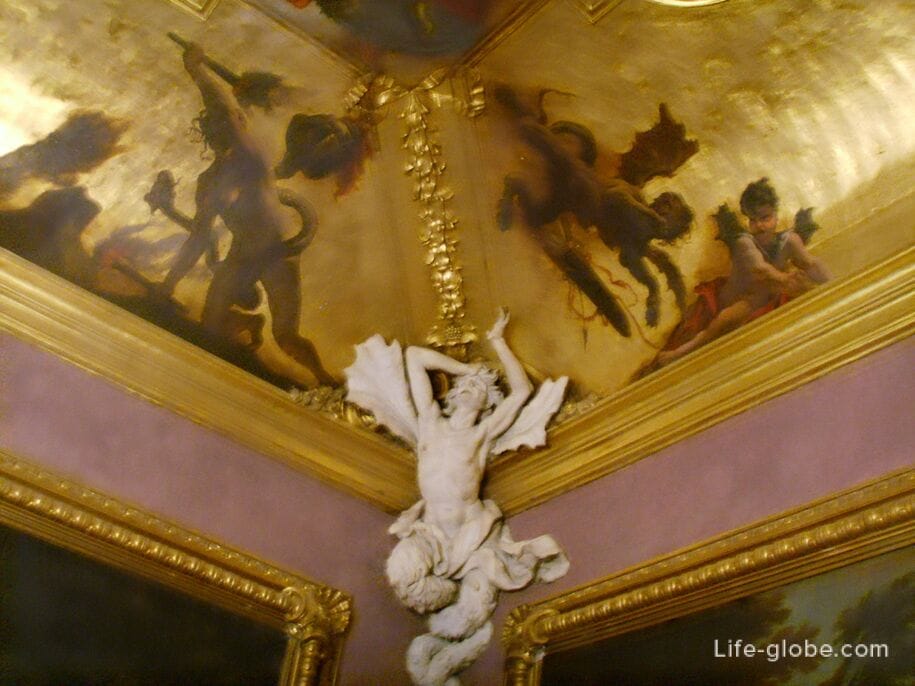
The Palazzo Antinori is considered one of the most beautiful Renaissance palaces in Florence.
The palace was built between 1461 and 1469 for Giovanni di Bono Boni. The unfinished building was put up for sale by the Boni family due to financial difficulties in 1475 and later passed to the family of the patrician of Florence, Martelli. In 1506, the palace passed to Niccolo Antinori, who made changes and improvements. Probably, the task was assigned to Baccio d'Agnolo, who designed the rear facade and the inner garden, giving the building its current dimensions.
Since then, the Antinori family still lives in the palace and owns lands throughout Tuscany, where the famous wines and wines of Santo, as well as oil and other products are produced.
The palace has a courtyard and a fountain with a garden, and, what especially attracts guests, on the ground floor of the palace there is a historic family wine bar-shop, including the possibility to book an individual tasting. Website: antinori.it.
Address of the Antinori Palace: Piazza degli Antinori, 3, 50123 Firenze FI, Italy.


In the wall of the Antinori Palace, facing Antinori Street, you can see a tiny arched opening with a door. These openings in Florence have been used and are sometimes used (as for example, under the restrictions associated with the Covid-19 pandemic) to sell wine through a window directly onto the street. Such windows are called "Wine holes" (Buchette del vino).
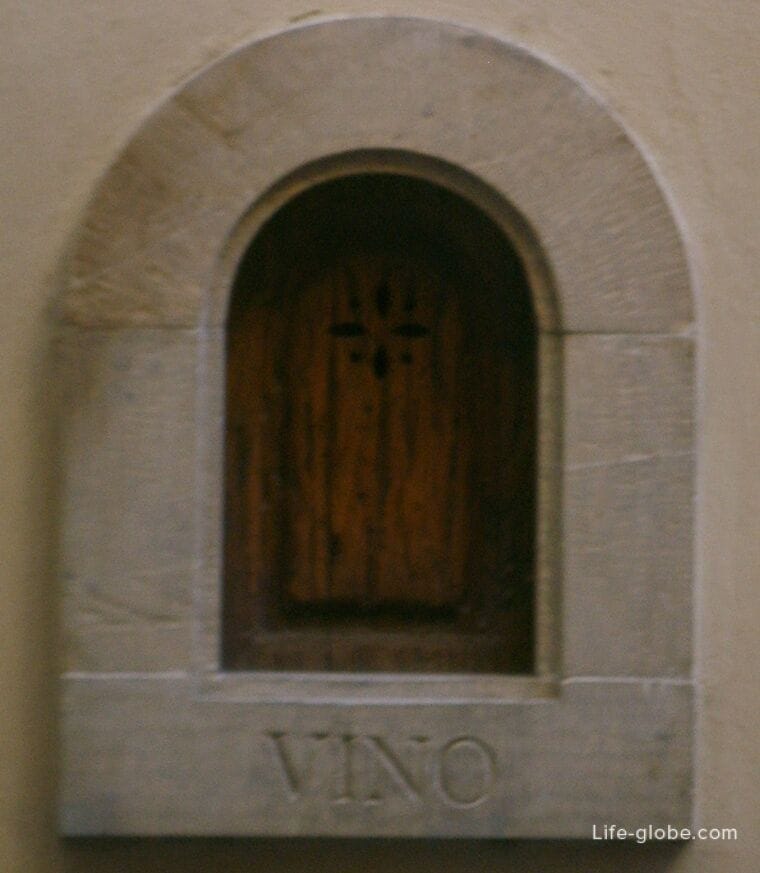
The Royal Palace of Santa Maria Novella (Palazzina Reale di Santa Maria Novella) was built around 1935 and opened on October 30, 1935 in the presence of King Vittorio Emanuele III and Minister Costanzo Ciano.
The palace was intended as a stop and temporary residence of the king and the court, after the Pitti Palace was opened as a museum.
The building has a courtyard with columns and is characterized by the jewel of the finishing materials and the sophistication of the details in the decoration.
The address of the palace: Santa Maria Novella, 50123 Firenze FI, Italy.
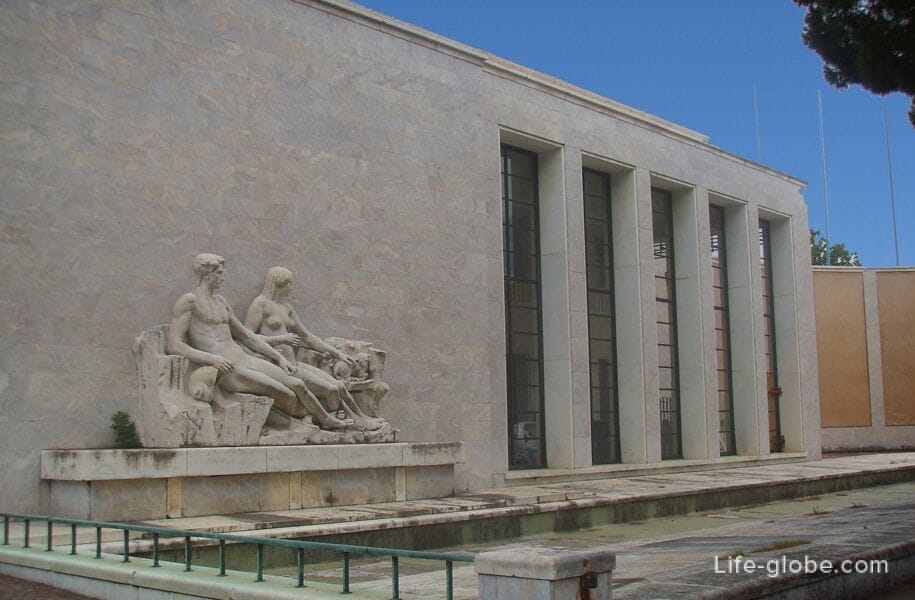
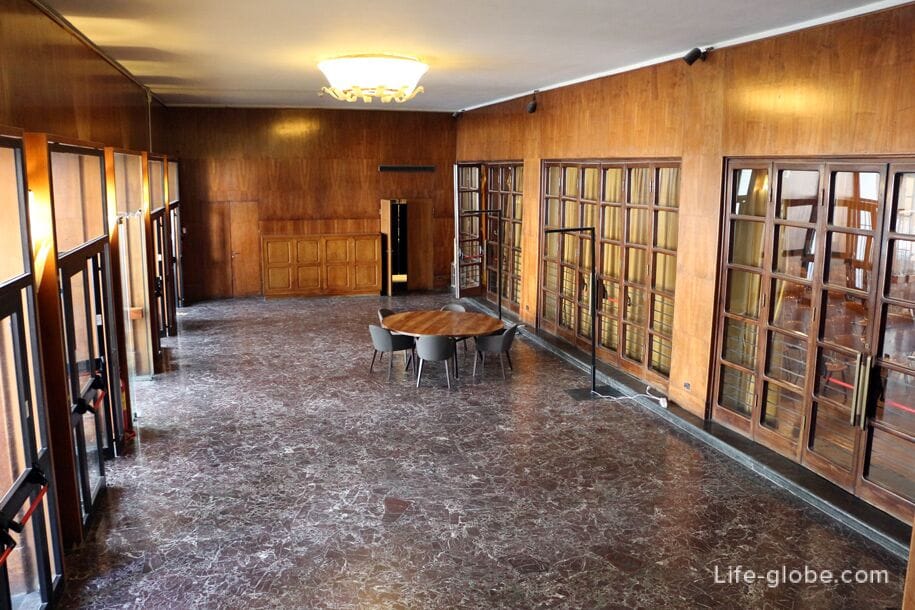
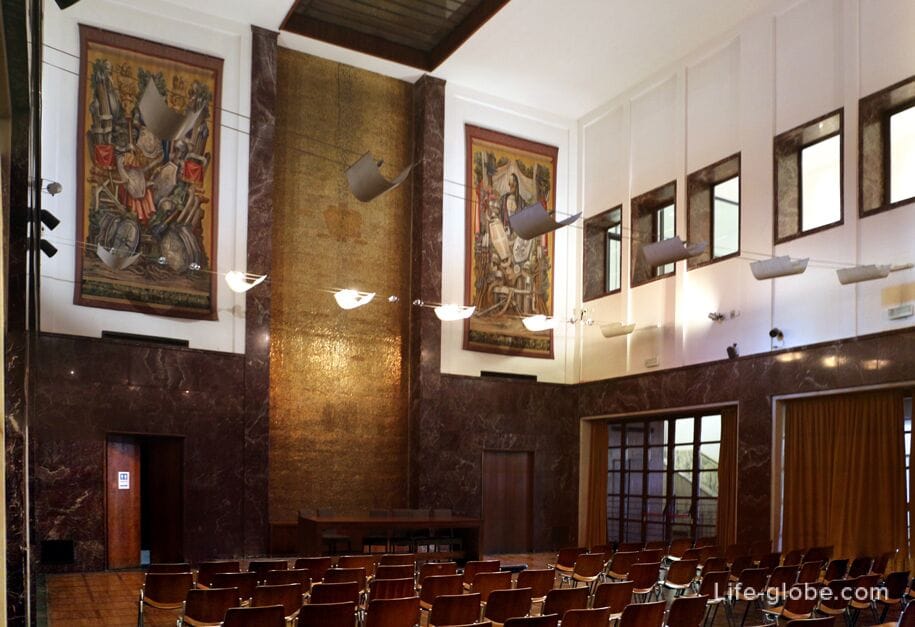
In Florence there are villas that belonged to noble families, of course, both Medici and rich people.
Of the most famous and visited villas, Villa Bardini stands out, surrounded by the Bardini Garden of the same name (Giardino Bardini) - a historic Italian Renaissance complex, which is an ensemble that is among the top attractions of Florence.
The garden offers beautiful panoramic views of Florence, and in the garden itself is Villa Bardini, which houses the Annigoni Museum (Museo Annigoni) and hosts temporary exhibitions.
Entrance to the gardens and the villa is paid.
Entrance to the Bardini Garden from Via dei Bardi 1 red and Costa San Giorgio 2.
Website of the villa and gardens of Bardini: villabardini.it. More about Villa and Bardini Gardens…
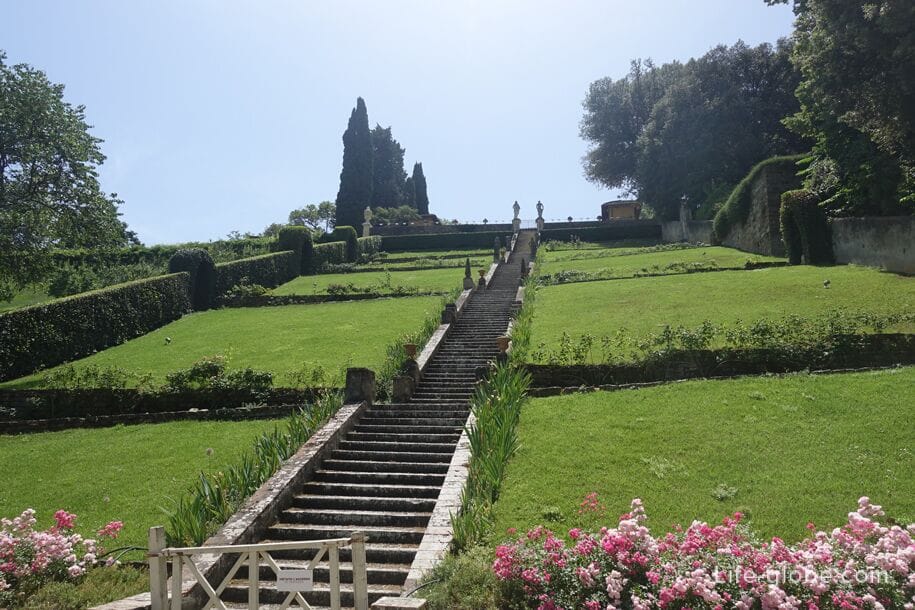
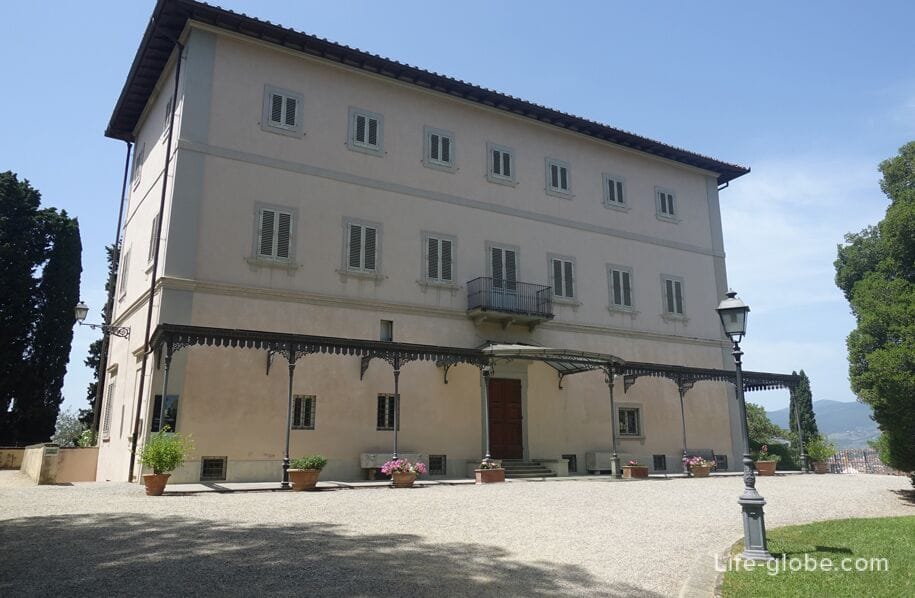
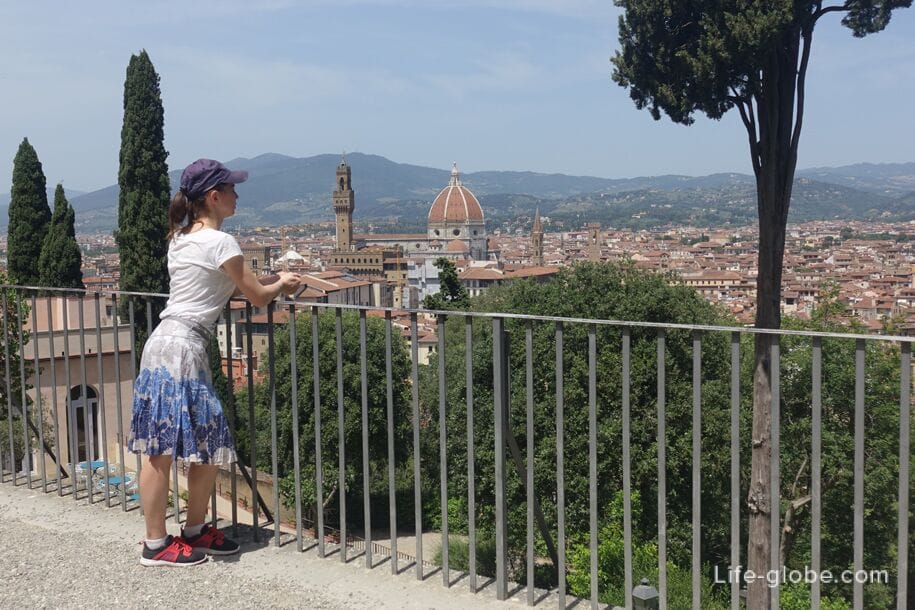
Within Florence there are other villas with gardens, historical interiors and museums, most of which at various times belonged to the Medici family, and which today can be visited, including on request, by appointment, on certain days and hours or with excursions.
Of the most beautiful and significant villas: Villa Corsini (Villa Corsini), Villa Montughi (Villa Montughi), which now houses the Stibbert Museum (Museo Stibbert), Villa Petraia (Villa La Petraia) with a covered courtyard and a beautiful Italian garden, Villa Castello (Villa di Castello) with a historic garden with grotto and fountain, complex villa-museum Quiet (Villa La Quiete) with garden and church.

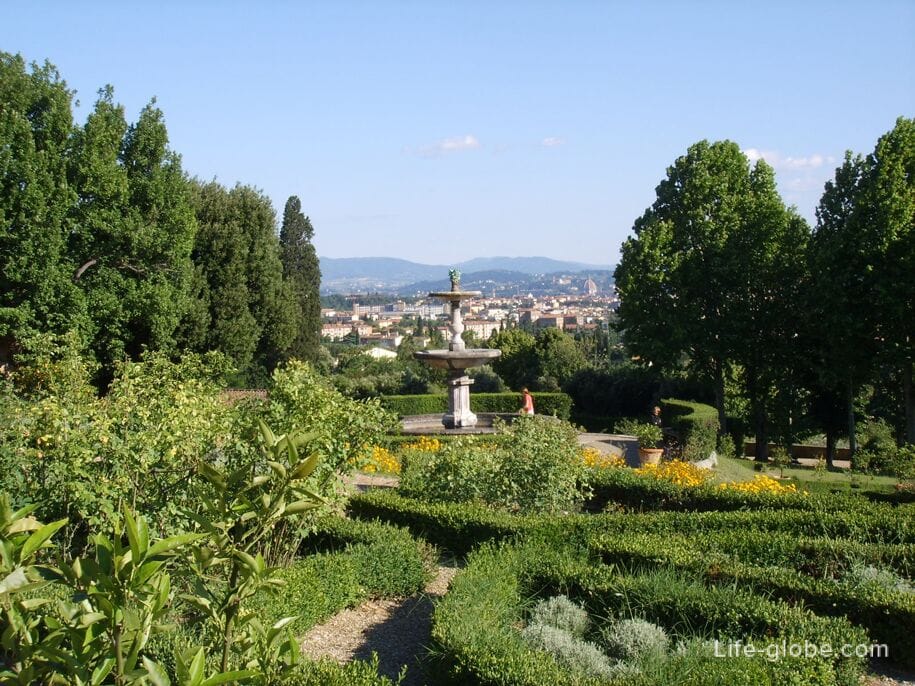
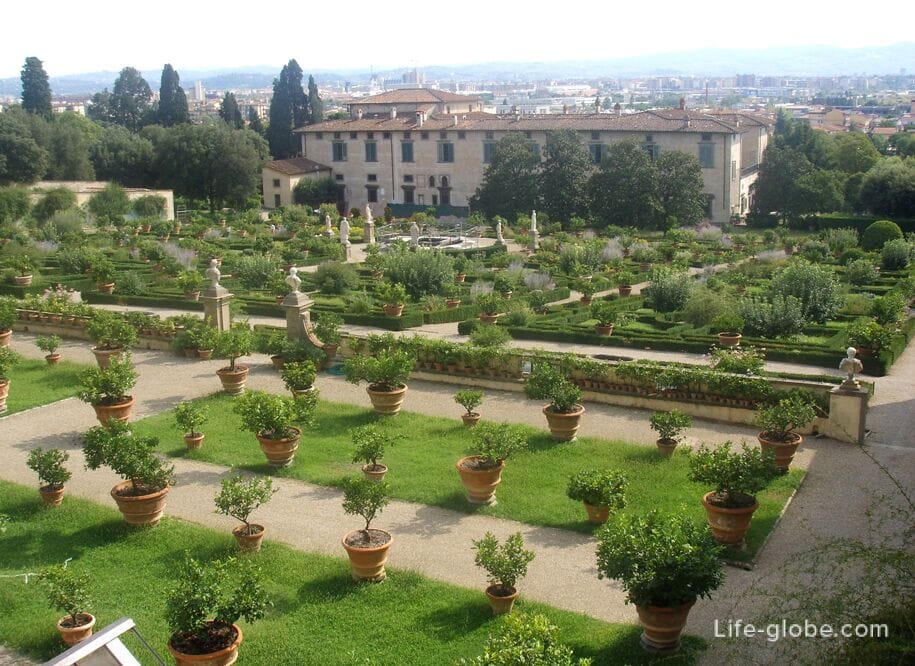
Also in Florence is the remarkable Villa Medici in Poggio Imperiale (Villa Medicea del Poggio Imperiale), which has been the residence of the Santissima Annunziata State College since 1865.
The villa originally belonged to the Baroncelli family, then to the Pandolfini and finally to the Salviati, before Cosimo I de' Medici seized the property and presented it to his daughter Isabella, who married Paolo Giordano Orsini.
Today the villa is a UNESCO World Heritage Site. The villa has a museum area with halls and a chapel with rich interior decoration with frescoes and sculptural decoration. Visit the museum area by appointment.
Website: museo-visite-guide.
Villa address: Piazzale del Poggio Imperiale, 50125 Firenze FI, Italy.
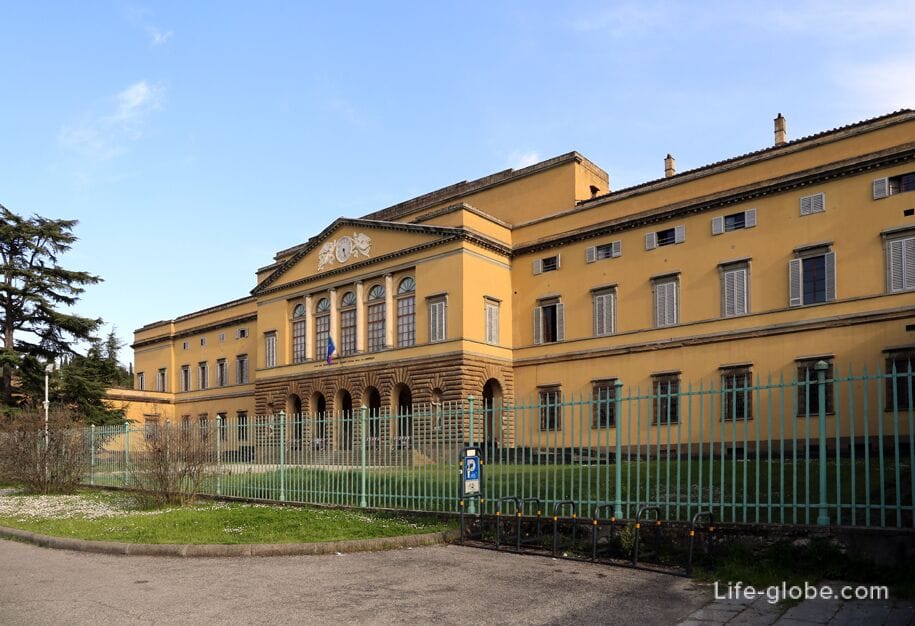

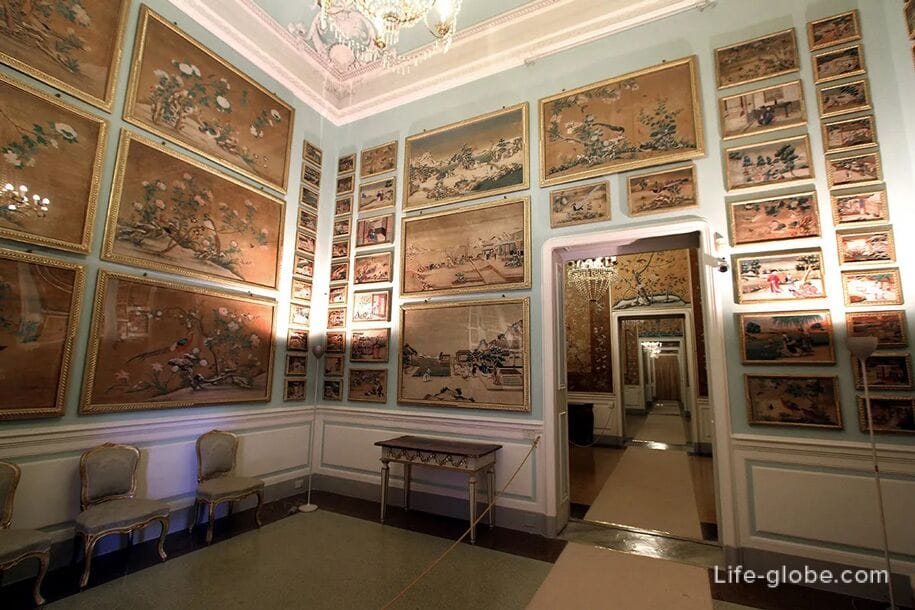
Fort Belvedere (Forte di Belvedere) can also be considered as a villa and residence of the Medici dynasty, since it was erected as a city fortress by the Italian architect Bernardo Buontalenti between 1590 and 1595 by order of Grand Duke Ferdinando I Medici. Michelangelo was the chief engineer of the fortifications.
The fortress is located on a high hill, has a polygonal plan and a small villa in the center. The villa is a central building that served as the residence of the Grand Duke in unhealthy times, both for personal residence and for protection.
Today, the Fort villa can be visited; various exhibitions and events are held here, and the fort is also considered one of the best viewing platforms in Florence.
The cost of the entrance ticket depends on the exhibition being held.
Fort Villa address: Via San Leonardo 1, 50125 Firenze FI, Italy. More about Fort Belvedere…
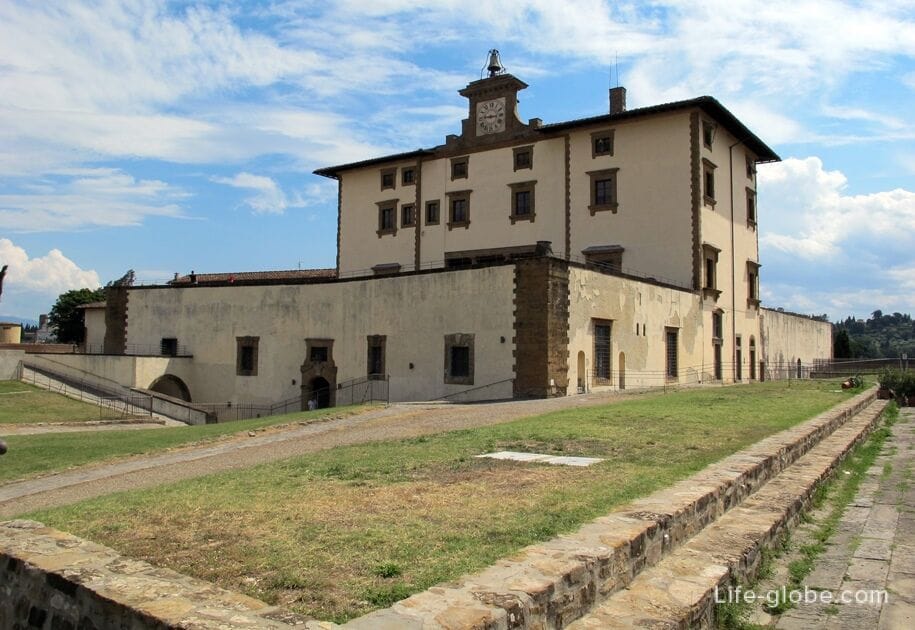
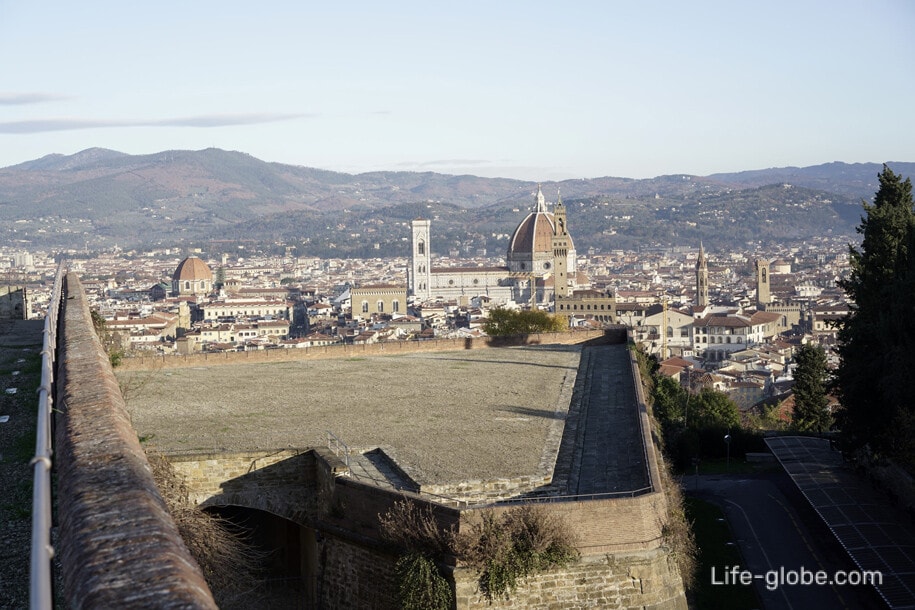
All accommodation facilities in Florence (hotels, apartments, guest houses, etc.), including those in the historical center of the city and more remotely from it, can be view and book here